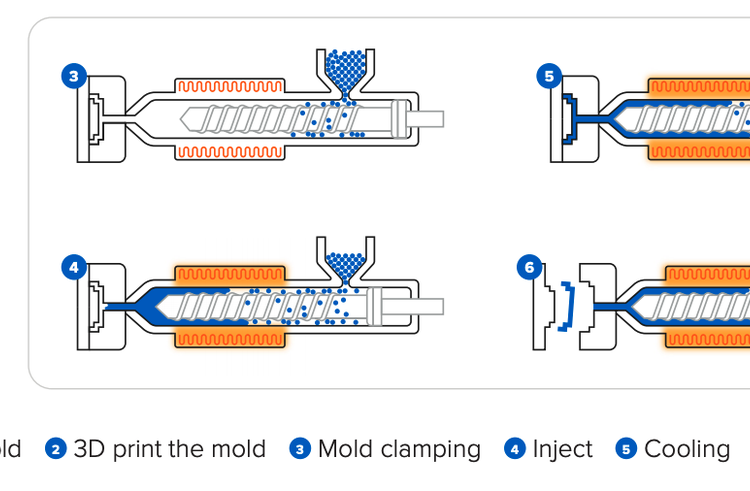
I. Introduction to Repairing Rare Parts with 3D Printing and Molding
II. Step 1: Assessing the Damage and Selecting the Right Repair Method
III. Step 2: 3D Printing the Replacement Part
IV. Step 3: Creating a Mold for Future Repairs
Imagine this – you have a beloved vintage car, and while restoring it to its former glory, you realize that a crucial part is damaged and nearly impossible to find. What do you do? This is where the magic of 3D printing and molding comes into play, allowing you to repair rare parts with precision and efficiency.
Whether you’re a hobbyist, a DIY enthusiast, or a professional in need of a unique solution, the combination of 3D printing and molding opens up a world of possibilities. With the right tools and techniques, you can breathe new life into old, hard-to-find parts, saving you time, money, and the headache of hunting down rare replacements.
In this guide, we’ll walk you through the process of repairing rare parts using 3D printing and molding, giving you the confidence to tackle any restoration project with ease. So, grab your tools and let’s get started!
Step 1: Assessing the Damage and Selecting the Right Repair Method
Hey there! So, you’ve got a rare part that needs some fixing, huh? Well, the first step in this process is to take a good look at the damage and figure out the best way to repair it. Let’s break it down!
First things first, grab your handy dandy magnifying glass and really examine the part. Is it a small crack? Or maybe a missing piece altogether? Understanding the extent of the damage will help you determine the right approach to take.
Once you’ve assessed the damage, it’s time to choose the right repair method. This is where things can get a bit tricky, but fear not, I’m here to guide you through it!
If the damage is minor, like a small crack or chip, you may be able to simply glue the part back together. Make sure to use a high-quality adhesive that is compatible with the material of the part. This method is quick and easy, but keep in mind that it may not be the most durable solution for more significant damage.
For more complex repairs or when a part is missing altogether, you may need to consider 3D printing a replacement part. This technology has revolutionized the way we approach repairs, allowing us to create custom parts with precision and accuracy. Just make sure you have access to a 3D printer and the necessary skills to design and print the replacement part.
Now, if you want to be extra prepared for future mishaps, creating a mold of the part is a great idea. This way, you can easily replicate the part whenever needed without having to go through the entire repair process again. Plus, molds can be used for multiple repairs, saving you time and effort in the long run.
Remember, each repair situation is unique, so take your time to assess the damage and choose the best method for your specific needs. And don’t be afraid to ask for help if you’re unsure about how to proceed – there are plenty of resources and experts out there willing to lend a hand.
So, there you have it – assessing the damage and selecting the right repair method is the crucial first step in fixing rare parts. Take your time, be thorough, and don’t be afraid to get creative with your solutions. Happy repairing!
So, you’ve assessed the damage and selected the right repair method, and now it’s time for the fun part – 3D printing the replacement part! This step is where the magic happens, where you get to bring your rare item back to life with the help of modern technology.
First things first, you’ll need to have a 3D model of the part you’re looking to replace. This can be created using CAD software or downloaded from online repositories if available. Make sure the dimensions and specifications are accurate to ensure a perfect fit.
Choosing the Right Material
When it comes to 3D printing, there are a variety of materials to choose from. Each material has its own unique properties and strengths, so it’s important to select the right one for your specific needs. For repairing rare parts, you’ll want to choose a material that is durable, strong, and can withstand the wear and tear of everyday use.
ABS and PLA are popular choices for 3D printing replacement parts due to their strength and durability. ABS is known for its toughness and impact resistance, making it ideal for parts that need to withstand heavy use. PLA, on the other hand, is easier to print with and is biodegradable, making it a more environmentally friendly option.
Printing the Replacement Part
Once you have your 3D model and material selected, it’s time to start printing! Make sure your 3D printer is calibrated correctly and that the bed is leveled to ensure a successful print. You may need to adjust the settings such as layer height, infill density, and print speed to achieve the best results.
It’s important to monitor the printing process to catch any errors or issues early on. Check the print periodically to ensure that it is coming out correctly and that there are no defects. If you encounter any problems, don’t be afraid to stop the print and make adjustments as needed.
Post-Processing
Once the print is complete, remove it from the build plate carefully to avoid damaging the part. Depending on the material used, you may need to do some post-processing to clean up any rough edges or imperfections. Sanding, painting, or smoothing the surface with acetone vapor can help achieve a professional finish.
Before installing the replacement part, make sure it fits correctly and functions as intended. Test it out to ensure that it works seamlessly with the rest of the item. If everything looks good, you’re ready to move on to the next step – creating a mold for future repairs.
When it comes to repairing rare parts with 3D printing and molding, one key step that can save you time and effort in the long run is creating a mold for future repairs. By having a mold ready, you can easily replicate the replacement part whenever needed, ensuring that your rare item stays in top condition without the need to start from scratch each time.
Step 3: Creating a Mold for Future Repairs
Creating a mold may sound daunting, but with the right approach, it can be a straightforward process that will make your repair projects much more efficient. Here are some tips to help you get started:
- Select the Right Material: When creating a mold, it’s important to choose a material that is durable and can withstand the pressure of the molding process. Silicone rubber is a popular choice for making molds as it is flexible, heat-resistant, and easy to work with.
- Prepare Your Workspace: Before you start creating the mold, make sure your workspace is clean and organized. Having all your tools and materials ready will help streamline the process and prevent any unnecessary delays.
- Create a Mold Box: To contain the mold material and ensure a clean finish, you’ll need to create a mold box using materials like cardboard or plastic. This will help define the shape of the mold and prevent any leakage during the molding process.
- Mix and Pour the Mold Material: Follow the manufacturer’s instructions to mix the silicone rubber and pour it into the mold box. Make sure to eliminate any air bubbles by tapping the mold box gently on a flat surface. Allow the mold to cure according to the recommended time frame.
- Remove the Original Part: Once the mold has cured, carefully remove the original part from the mold. Take your time and be gentle to avoid damaging the mold or the part itself.
- Test the Mold: Before using the mold for a repair project, it’s a good idea to test it with a small batch of resin or other material to ensure that it produces accurate and high-quality replicas of the original part.
- Store the Mold Properly: To ensure that your mold lasts for multiple uses, store it in a cool, dry place away from direct sunlight and extreme temperatures. Proper storage will help maintain the integrity of the mold and ensure consistent results each time you use it.
By following these steps and taking the time to create a mold for future repairs, you’ll not only save yourself time and effort but also ensure that your rare parts are well-maintained and can be easily replaced whenever necessary. With a well-made mold at your disposal, you’ll be equipped to tackle any repair project with confidence and precision. Happy repairing!










Comments